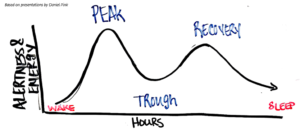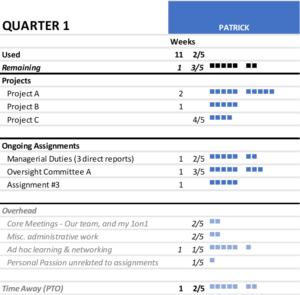Tune the When, How Much, and What in Your Days
You can have balance, productivity, and meaning when you know how to tune the when, how much, and what of your activities. Let me share what I’ve learned to achieve this over the past four years.
WHEN. Converging evidence from psychology, biology, and economics show the natural patterns of alertness and energy that define our “chronotypes” – the personal patterns “of circadian rhythms that influences our psychology and psychology.”[i] Daniel Pink reviews this evidence in part 1 of When: The Scientific Secrets of Perfect Timing. Everyone has a peak, trough and a recovery in their alertness – varied by our chronotype.

Based on this, he suggests we:
- Know our chronotype.
- Larks are most alert in the early morning,
- Third birds are most alert in the mid-morning, and
- Owls are most alert in the late afternoon.
- Align our activities to fit our chronotypes, as shown here[ii]:
| Larks | Third Birds | Owls | |
| Analytical tasks | Early morning | Early to midmorning | Late afternoon and evening |
| Insight tasks | Late afternoon/early evening | Late afternoon/early evening | Morning |
| Administrative tasks | Early afternoon | Early afternoon | Early afternoon |
| Making an impression | Morning | Morning | Morning (sorry, owls) |
| Making a decision | Early morning | Early to midmorning | Late afternoon and evening |
- Use breaks to restore energy in the trough of the day. For example, caffeine drinkers may benefit from Pink’s suggestions to down a cappuccino and take a 26-minute nap. You’ll get the double boost of the power nap and the caffeine hitting your bloodstream (which takes ~ 26 minutes).
This set of practices alone created a flow in my day. Avoiding high risk or demanding activities in the trough of my early afternoons is especially helpful. When I cannot avoid them, knowing I’m in a trough helps me better modulate my response to challenging, frustrating, or tense situations.
Cal Newport expands on this notion of when to work in Deep Work. He suggests that “High-Quality Work Produced = (Time Spent) x (Intensity of Focus)” and suggests we might consider batching work across several days.[iii]
HOW MUCH AND WHAT. My remaining results came from me scrutinizing how much time I spent on each activity. Newport makes the case for a fixed-schedule from his experience at Georgetown and Radhika Nagpal’s experience at Harvard.[iv] In a three-year pre-tenure period on faculty, Newport didn’t work nights and rarely worked weekends while delivering 20 peer-reviewed articles, two competitive grants, one (nonacademic) book, and more.
For me, I began forecasting my workload on a quarterly basis in estimations that were good enough to be useful – anywhere from hours to ½-days of effort. The results are displayed in weeks of effort like this example outlined for my staff-administrative job:

Workload Forecast. (Weissenburger)
In this, I accounted for three (3) givens:
- A workday of effort equals 6 hours, rather than 8 hours to accommodate getting organized at the start and end of the day; handling smaller, urgent tasks; and taking a break during the trough of the afternoon.
- Potential days off work for vacations, holidays, illnesses, etc.
- Activities that are constant for every worker in the profession (Overhead). For my profession, that is a basic set of standing meetings, time for learning and networking, and some others.
This forecasting data drove decisions about what activities I had and how much time I’d devote to them.
In advocating for fixed-schedule productivity, Newport and Nagpal (see her post) make the case that there’s a limit to how much time you can give to your work while maintaining a meaningful, happy life. In response, they scrutinized what they were doing and set quotas on the remainder, each commensurate with the activity’s value return. The results are academic lives that are highly productive with limited time outside classic working hours (e.g. Mon – Fri, 8-5).
Whether you keep to 40-50 hours per week or not, the habits of aligning your work with your daily energy flow and managing your time like a fixed-expense budget fosters better decision making by you and others who control your commitments.
You can read more about all these here:
- My article on these practices that include details on how I manage my schedule and workload forecast.
- Daniel Pink’s When
- Radhika Nagpal’s post in Scientific America online: The Awesomest 7-Year Postdoc or: How I Learned to Stop Worrying and Love the Tenure-Track Faculty Life – Scientific American Blog Network
- Cal Newport’s Deep Work, and his blog
[i] Pink D. When. New York (NY): Riverhead Books; 2018. 27 p.
[ii] Pink D. When. 40 p. with modification: added row for administrative tasks based on Pink’s findings.
[iii] Newport C. Deep Work. New York (NY): Grand Central Publishing; 2016. 39-40 p.
[iv] Newport C. Deep Work. 236-242 p.
More Resources
How to REALLY Manage Your Time
Finding Your Science Flow: Yoga Lessons to Increase Productivity
Not that Kind of Investment: Tales of Time Commitment
Home Page ImageCreator: Microsoft Office stock images






0 Comments